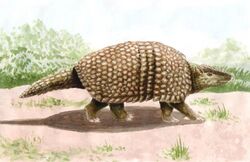Biology:Scirrotherium
| Scirrotherium | |
|---|---|

| |
| Life reconstruction of Scirrotherium | |
| Scientific classification | |
| Domain: | Eukaryota |
| Kingdom: | Animalia |
| Phylum: | Chordata |
| Class: | Mammalia |
| Order: | Cingulata |
| Family: | †Pampatheriidae |
| Genus: | †Scirrotherium Edmund & Theodor, 1997 |
| Type species | |
| †Scirrotherium hondaensis Edmund & Theodor, 1997
| |
| Species | |
| |
Scirrotherium is an extinct genus of pampatheres, a family of herbivorous cingulates, related to the similar but smaller modern armadillos, and with the now extinct glyptodonts, well-known from their shell-like armor. Its scientific name is derived from the Greek prefix "skiros-", "cover", and the suffix "-therion, "beast", while the name of the type species, hondaensis, honors the town of Honda, in the Tolima Department of Colombia.[1] Scirrotherium is one of several genera of xenarthrans found in the La Venta fauna, dated from the Middle Miocene.
Description
Scirrotherium is only known from an incomplete skull preserving teeth, a fragmentary mandible, postcranial vertebrae, and parts of its osteoderm armor. These remains were smaller than in its relative Kraglievichia, and larger than those of Vassallia.[1] Scirrotherium was characterized by its cylindrical molars, a bilobed eighth lower molar, and by the presence in the third thoracic vertebra of a disc-shaped surface, conjectured to have had a little mobility.[1] In Scirrotherium hondaensis, the mobile osteoderms presented in the sculpted area foramina aligned in two rows, with marked lateral edges, and a short, rounded and narrow axial elevation. The fixed osteoderms had fewer foramina arranged in the form of an arch with a posterior concavity and a narrower longitudinal central elevation, delimited by superficial longitudinal depressions.[2] Pampathere osteoderms attributed to this genus, from the Ituzaingó Formation in the Entre Ríos Province of Argentina , the Puerto Madryn Formation in the Valdes Peninsula in Argentine Patagonia and the Solimões Formation in the Brazil ian State of Acre, under the species S. carinatum[3] have some anatomical differences with the type species, such as the anterior foramina of the mobile osteoderms arranged in a row and a longitudinal central elevation carinated.[2]
References
- ↑ 1.0 1.1 1.2 G. Edmund and J. Theodor, 1997. A new giant pampatheriid armadillo. In: Kay RF, Madden RH, Cifelli RL, Flynn JJ, eds. Vertebrate paleontology in the Neotropics. The Miocene fauna of La Venta, Colombia, pp. 227–232. Washington, D.C: Smithsonian Institution Press.Engelmann, G.F.
- ↑ 2.0 2.1 Góis, Flávio; Scillato-Yané, Gustavo Juan. Nueva especie de Scirrotherium (Xenarthra, Cingulata, Pampatheriidae) del "Conglomerado osífero" (Mioceno tardío), base de la Formación Ituzaingó, provincia de Entre Ríos, Argentina. X Congreso Argentino de Paleontología y Bioestratigrafía-VII Congreso Latinoamericano de Paleontología. 2010
- ↑ Flávio Góis, Gustavo Juan Scillato-Yané, Alfredo Armando Carlini and Edson Guilherme (2013). "A new species of Scirrotherium Edmund & Theodor, 1997 (Xenarthra, Cingulata, Pampatheriidae) from the late Miocene of South America". Alcheringa: An Australasian Journal of Palaeontology 37 (2): 177–188. doi:10.1080/03115518.2013.733510. Bibcode: 2013Alch...37..177G.
Wikidata ☰ Q9075197 entry
 |

